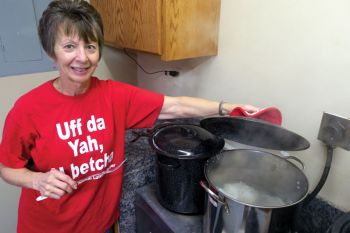The Gift of South Dakota
Subscriptions to South Dakota Magazine make great gifts!
Subscribe today — 1 year (6 issues) is just $29!
To All the Lutefisk We’ve Loved Before
Dec 22, 2020
I’ve always thought that neither snow nor rain nor heat nor gloom of night could keep a Norwegian from a plate of lutefisk, but this year has challenged that belief. COVID-19 forced the cancellation of family holiday get-togethers and community celebrations across the state, including the venerable Summit Lutefisk Supper. This would have been the 82nd annual feast and tribute to the finicky fish that both unites a culture and serves as punch line to countless jokes like this one: Did you know that the first person to fly an airplane solo across the Atlantic Ocean was not Charles Lindbergh but a Norwegian pilot from Minnesota? Unfortunately, his plane carried a cargo of lutefisk, so no one met him at the airport.
Lutefisk is a culinary oddity whose origins are tough to pin down. A popular folk tale says it all began more than 1,000 years ago when Irish citizens, hoping to poison a group of pillaging Vikings, boarded the Norse long ships and poured lye over their fish. But instead of dying, the Norwegians ate heartily and declared the lye-soaked fish a delicacy. Another reference in a 16th century book tells of a successful Norwegian fishing trip to the North Atlantic. After the men had eaten their fill, they left the remaining cod on the beach. Birch ash leftover from their fires combined with water to create lye, or “lute.” The fishermen noticed that it had perfectly preserved their catch. All they needed to do was rinse, cook and eat. The method was passed through Norwegian families for generations.
We traveled to Summit a few years ago to see how the town of 290 people stages an event that often draws twice that many diners. It seems nearly everyone in town has a job. Two days before the feed, fourth graders at the Summit school devote their physical education class time to hauling tables and chairs and setting them up on the old gym floor of the Summit Hall. On Friday night, high school honor society members carefully assemble each place setting. There are butter melters, lefse makers, coffee brewers, dishwashers and the all-important lutefisk chefs, led by Diane Knutson and Sheryl Steinocker, both veterans of at least 40 lutefisk suppers.
We watched as they prepared the fish for that evening’s dinner. Water boiled steadily in two pots while they explained the process. The fish is placed inside cheesecloth and plunged into boiling water. “They used to say 4 or 5 minutes, but you can’t go by that because some pieces are thicker than others,” Knutson said. “So we stab each bag.”
Lutefisk. Cheesecloth. Boiling water. Five minutes. It sounds simple, but there’s a lot riding on the preparation. “It has to be fork tender,” Steinocker said. “There’s a fine line.”
“And a true lutefisk lover knows where that fine line is, so we have to get it right,” Knutson adds.
When they get it right, they can see it in the empty platters that return to the kitchen almost as quickly as they left. “Sometimes the plate makes it all the way around the table, and other times it only makes it through two people,” Knutson said. “That’s how you tell who the real Norwegians are.”
Even in pre-pandemic years, lutefisk suppers didn’t seem to fill the fall calendar in South Dakota as they once did. Perhaps younger generations aren’t as enamored with the idea of eating fish that is preserved in lye. Maybe it’s the distinctly fishy aroma that can emanate from a boiling pot of lutefisk, or the gelatinous texture it can take on when overcooked. Still, the lutefisk suppers that remain often sell out, attracting diners who both truly love the fish and those who are willing to eat it once a year for the sake of nostalgia or to preserve their cultural heritage.
We’ll have to put the fun and fellowship that comes with community suppers like the Summit lutefisk feed aside for the moment, but cod willing, we’ll be back in 2021.










Comments
I remember the dinners, even tho I cannot stand lutefisk. Thank goodness they always made swedish meatballs for the yournger folks like me.
And I stil remember the odor. Not good.